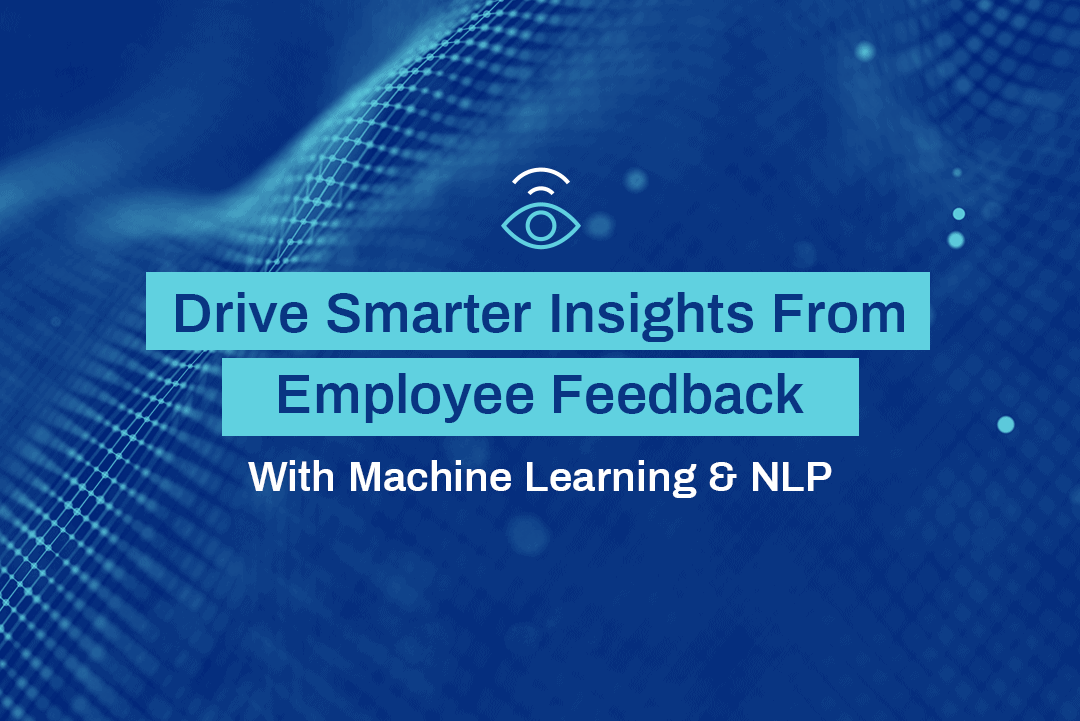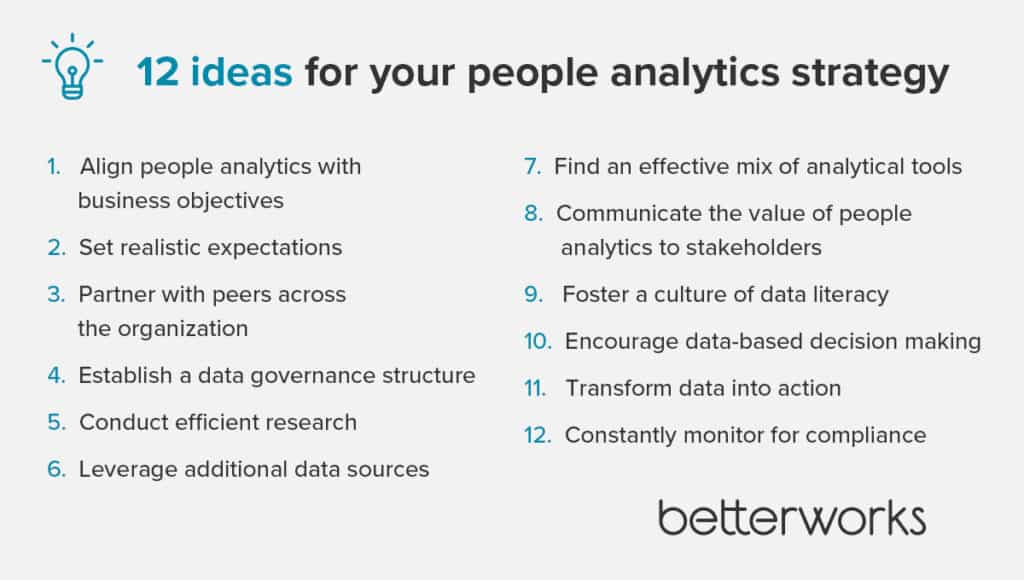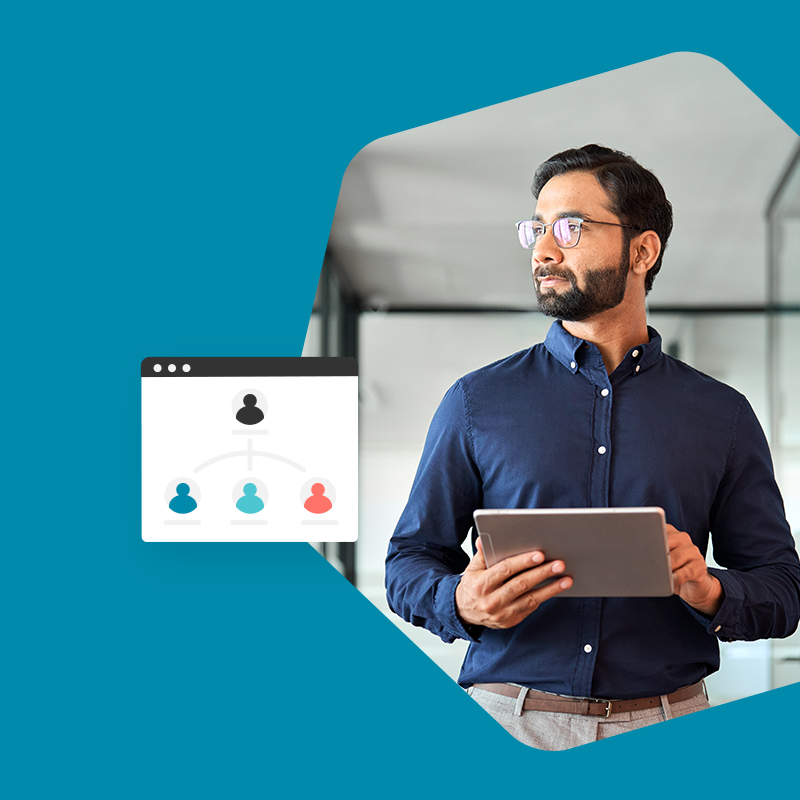- What is people analytics?
- 12 effective ideas for your people analytics strategy
- Align people analytics with business objectives
- Set realistic expectations
- Partner with peers across the organization
- Establish a data governance structure
- Conduct efficient research
- Leverage additional data sources
- Find an effective mix of analytical tools
- Communicate the value of people analytics to stakeholders
- Foster a culture of data literacy
- Encourage data-based decision-making
- Transform data into action
- Constantly monitor for compliance
- How can a people analytics strategy improve your HR performance?
Technology is integrated into every aspect of human resource management, generating millions of data points to inform your workforce decisions. But to make the most of that data, you need a people analytics strategy.
People analytics uses HR and business datasets to generate insights and quantify the effectiveness of your workforce. This data comes from HR software, such as performance management systems and applicant tracking systems, but it can also come from productivity software and communications systems that employees work in every day When HR leaders combine this information with other organizational data and properly analyze it, the resulting insights help organizations take a data-driven approach to understanding the precursors to productivity and solving workforce problems.
People analytics requires specialized HR systems and procedures to generate useful and actionable insights. Meticulous planning, an open mind, and the willingness to change course are important soft skills for enterprise HR teams looking to take full advantage of people analytics’ potential.
Learn more about people analytics, including 12 best practices for designing and executing your people analytics strategy.
What is people analytics?
People analytics is the practice of using data to measure and analyze the performance, attitudes, and behaviors of employees in an organization. It is a subset of business analytics that focuses on people-related data such as employee surveys, data measuring engagement, turnover, and performance.
People analytics combines data from multiple sources to understand the impact your people have on business processes. These insights can help you make better decisions about workforce staffing and talent management.
12 effective ideas for your people analytics strategy
Apply these ideas to ensure a standardized approach to collecting, reporting, and analyzing relevant employee data when implementing people analytics.
Align people analytics with business objectives
Work closely with your peers in leadership to identify how people analytics supports the business and drives outcomes. Take your cues from the business strategy: What are your organization’s biggest upcoming strategic priorities? How can your people data and analytics strategy improve those outcomes?
If an overarching business goal is to increase production efficiency, for example, then the goal for your people analytics project might be to increase employee engagement by 10% over the next 12 months on the assumption that engaged employees tend to be more productive and efficient.
Set realistic expectations
Implementing HR analytics isn’t a magic bullet. Analytics solutions are great for assessing where you stand, how to improve HR processes, and how to support the business. But all of this takes time.
Before you can conduct data analysis, much less implement a course of action, you must put key elements into place. You need to select the right HR analytics software tools, redesign internal processes to collect the best data and educate critical stakeholders. And all of that is before you collect and analyze data.
Your people analytics team will need time up front to determine the scope, direction, and techniques that work best for analyzing data. They’ll compare that information against HR metrics and the HR data collection itself. This work isn’t easy, and your team has finite time and resources. They can’t accept every request from throughout the business.
To avoid overwhelming your people analytics team, confirm your priorities early on – and remind people of them as new requests come in. As your people analytics program matures, you can invest in training and resources so business leaders and front-line managers can self-service their basic analytics needs effectively.
Progress might seem slow at first, but if you’re deliberate in your people analytics implementation, your patience will be rewarded.

Partner with peers across the organization
Leaders in departments such as finance, operations, and marketing can contribute to your data strategy by offering unique perspectives into the organization’s current state and how they use data. These outside perspectives help you identify which people analytics questions are most important, which have traditionally gone unaddressed, and what data points you need to answer those questions.
Establish a data governance structure
Before you can make the most of your HR analytics dataset, you have to prepare for effective and compliant data management. Organizations have to decide whether to store data on-premise via physical media, use cloud solutions from reputable providers, or some mix of on-premises and cloud storage. Talk to your peers in IT to review your options for data access and storage.
There’s always some risk involved when dealing with people data, especially in jurisdictions with data privacy laws such as the EU’s General Data Protection Regulation (GDPR). Establish data management/governance policies that define individual and collective responsibilities for managing data. Train anyone collecting or engaging with workforce data on how to maintain data accuracy, uniformity, security, and reliability.
At the organizational level, encourage the company to create a committee to oversee business data concerns. This committee should include HR, IT, security, legal, and operations. These stakeholders can design governance policies based on the business’ specific needs and risks.
Conduct efficient research
In today’s interconnected world, collecting data isn’t a problem. Millions, even billions, of data points are available through every software tool, and data collection is a cumulative process. But endless reams of information won’t do your business much good if you have poor data quality or lots of noise in your dataset.
Be selective in the data you collect and analyze. For people analytics purposes, concentrate on data and processes that drive business outcomes in a measurable way.
For example, if you’re looking at performance management, here are some questions you might ask:
- What data points are automatically collected through your performance management system or added by managers?
- Is the system prompting the most useful inputs, like performance progress over time or each team member’s skills and competencies?
- Are manager-employee conversations happening often enough to generate meaningful data?
If you’re trying to figure out what metrics are most valuable, look at key performance indicators (KPIs) and other quantitative tools that show progress toward business goals. Don’t waste time tracking HR metrics that don’t add value to the business.
Leverage additional data sources
In addition to the data generated by your HR tech stack, include data from other internal sources (such as systems of productivity, like Salesforce, or systems of interaction, like Microsoft Teams). Other important business metrics to feed into your data analytics tools include financial performance, skills data, sales data, operations data, employee sentiment from internal pulse surveys, and customer satisfaction surveys.
External data can also prove valuable, whether that’s industry benchmarks, publicly available people data, or something else that offers context and comparison. Industry reports and competitive analysis data, for example, can help you determine how effective your people strategy is compared against peers and competitors.
Find an effective mix of analytical tools
As you determine what people analytics tools you need, experiment with what’s on the market, and take advantage of free trial periods to minimize the financial commitment. Many vendors will work with you to determine whether their software is the right fit for your organization. You can also contract with a knowledgeable consultant during the selection process.
Besides HR analytics tools, a good place to start is with an up-to-date enterprise resource planning (ERP) platform. An ERP unites all of the business’s key functions, producing an integrated dataset. Choose an ERP with adaptable, scalable HR modules.
Ideally, you’ll find a single people analytics solution that can address multiple needs, like data mining and data analysis. But that’s not always possible, so be aware of how your ERP integrates with other tools, including your HR tech stack and people analytics tools.
Look for comprehensive solutions from reputable vendors with good track records and excellent customer service. When reviewing people analytics software options, bring additional stakeholders into the conversation. IT and security will be tracking these systems, for instance, so you’ll want their input as you decide.
Finally, evaluate each solution for the user interface. Your employees will have to use these tools, and they need interfaces that are easy to learn and simple to use. Your investment will go to waste if business leaders and HR professionals dislike using your workforce analytics tools or struggle to use them effectively.
Communicate the value of people analytics to stakeholders
Educate executives, managers, and employees on the power of data-driven decision-making. Each of these stakeholder groups will require a different approach if you want their buy-in. Executives likely want a high-level overview of the bottom-line impact of people analytics. Managers might have more granular questions about the strategy, as they’ll help collect data and will use the resulting insights to help their teams become effective.
Besides stakeholder-specific education, develop messaging around the general benefits of people analytics. Explain how this field provides insights into organizational performance to help your people make better decisions. Offer people analytics strategy examples so leaders can see how other companies have found success. And to make people analytics personal for employees, show how data-driven insights unlock opportunities for professional growth.
Foster a culture of data literacy
People analytics is dependent on sound, insightful data to drive the entire process. Unfortunately, the people data generated by an organization’s workforce has traditionally been viewed as subtle and qualitative — difficult to integrate within a quantitative system that’s dependent on KPIs.
But that belief is outdated. People data can be gathered, analyzed, and transformed using targeted, immediate feedback that reveals even nuanced data points within an employee base.
Showing the value of people analytics is part of the culture shift your organization needs to make. Employees must feel empowered to use data to make decisions that drive collaboration and innovation throughout the organization. Success builds on itself, as employees see how data-driven decision-making drives organizational outcomes in their day-to-day work.
Encourage data-based decision-making
Most workplace decisions should be made with data and other evidence, rather than through emotional reactions or intuition. Uninformed decisions are risky. Effective people analytics strategies solve this problem by letting you experiment with talent management processes with more information and less risk. Companies should aim for solutions that enable businesses to shift to analytics focused on business outcomes and performance.
“Most people analytics today is transactional — focused on reporting compliance measures, not strategic impact,” says Arnaud Grunwald, chief product officer at Betterworks.
Strategic people analytics, like those enabled by Betterworks Advanced Analytics, give HR the capacity to measure the strategic impact of people initiatives.
No decision is without risk, and no one has a perfect track record. But a data-driven approach to decision-making ensures that you take a grounded, rational approach, track your progress, and make adjustments over time to produce consistently strong outcomes.
For each talent analytics use case, use a core set of three or four key results as the basis of HR’s strategy and decision-making. Analyze key metrics such as attrition, absenteeism, recruiting, and other quantitative measures that affect the workforce and your organization.
Transform data into action
Raw data needs context that everyone can understand so they can use those insights to make better business decisions. To benefit from people analytics, your data has to tell a story. It fills in the blanks for the first and second acts of the narrative and, when interpreted correctly, provides direction for the final act. A narrative communicates your findings to key stakeholders. Translating the data and analysis into narrative form helps you glean meaningful insights, determine the right course of action, and communicate those conclusions to others. You can take it one step further by thinking about how to use data visualizations to help communicate your story. Tools like Betterworks Advanced Analytics, for example, can bring data to life with data visualizations that support your narrative and prompt stakeholders to act.
When you’ve effectively gathered people data, workforce analytics will reveal the most effective next steps.

Constantly monitor for compliance
All industries are subject to data and information regulations. Every organization needs an internal vetting process that ensures your data collection, analysis, and use falls within compliance standards and guidelines. And for regulations like GDPR, compliance is an ongoing process.
Data compliance takes numerous forms: clear policies, training on data practices, delegated monitoring and reporting responsibilities, and a single system to track data within the organization. This system should be able to detect suspicious or unauthorized activities. Schedule regular compliance checks to ensure that the organization is adhering to data governance policies.

How can a people analytics strategy improve your HR performance?
Your people analytics strategy provides actionable, data-driven insights to help everyone in the organization make better decisions. People analytics takes your data and helps you put it to work — proactively identifying what’s working and what needs to be improved, as well as developing targeted initiatives that drive business outcomes.
By leveraging the power of data, people analytics can create a competitive advantage for your organization. You’ll make better real-time decisions about talent, workplace policies, and strategic business direction. With the right implementation and adequate support, your people analytics strategy will become an invaluable asset for driving business impact through HR.
Discover how to use people analytics to take HR to the next level.






